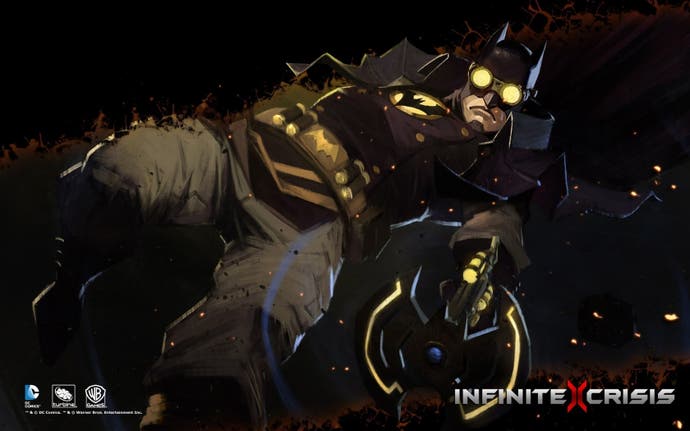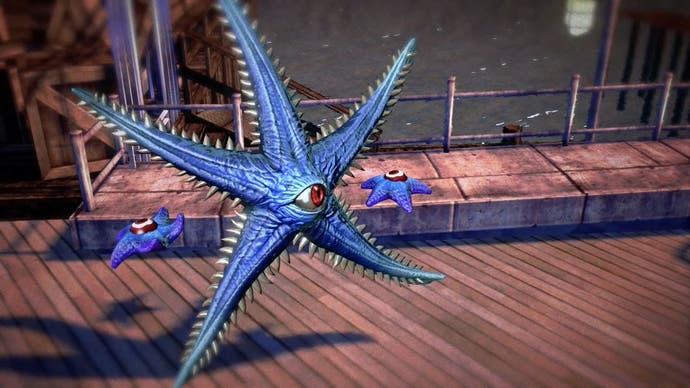Infinite Crisis and the fight to stay relevant
Stuck on loop.
Editor's note: This is an early impressions piece of Infinite Crisis. Our full review will be up in the near future.
As someone who began their writing career in music journalism, I'm well versed in the dark arts of pop. Go ahead, ask me anything! I was there for all the big events of 10 years ago: when Chris Cornell announced AudioSlave, and when Jamelia did a Reebok ad. My work in the field perfectly coincides with one of the most subdued periods for mainstream pop in decades. But for all my time spent in those trenches, my biggest takeaway as music writer was the resemblance between the commercial hits. Pop music, culture critic Simon Frith wrote, is a "matter of enterprise, not art." This is the nature of entertainment in the mainstream.
Maybe this is why I recognise a signature weariness on the faces of games journalists who've been asked to cover one of those ubiquitous, free battle arena, laning games. Those big empty faces, a hallmark of the people who've seen too much. This industry of free-to-play MOBA shares a lot with pop's enthusiasm for mass production. Last year alone saw the launch of six new battle arena games, not even including things like Heroes of the Storm or Dead Island: Epidemic which remain in beta. Is it just more pop? It's worth asking when playing a game like Infinite Crisis.
This is a project from Turbine, the company that helped ship the idea of free-to-play to the west with stuff like Dungeons & Dragons Online. It's being made with DC Comics' blessing too: Infinite Crisis, which is loosely based on the comic book series of the same name, benefits from DC's whole stock of characters and universes. Unsurprisingly, the studio is leaning heavy on the DC pedigree, going as far as digging out a few of the lesser-known names.

British, chubby, weird-looking and with a vocal cheeriness that makes me think he would mix a good daiquiri, Gaslight Batman-a steampunk, electric version of the Bruce Wayne alter-ego with a lineage that runs all the way back to an '89 one-shot comic -is the first champ you meet as you manoeuvre the early tutorial.
The game sees players assume the role of a Protector who dictates the actions of their DC hero. The aim is to take out the enemy base power core as part of a team of five. It's a classic set up. Minions spill out of both bases, turrets stand as defence between teams. But Turbine's money is on its heroes. Harley Quinn, Lex Luthor, Zatanna, Krypto the Super Dog, Starro the Lovecraftian squid thing. While the first few champs are unlocked for you, the rest can be bought with in-game or real currency as part of a free-to-play economy anyone with a passing knowledge of these games will recognise.
Here's where it differs: It's probably the chattiest MOBA I've ever played. Turbine has enlisted the help of voice actors for all of its 41 characters, including fully-voiced tips that trigger when you start struggling. It's an immense amount of work: An audio guide to the elusive concept of MOBA metas, explained with entry-level terminology for the guys who just came for Superman. You'll get character-specific suggestions tailored to your class, reminders for when to meander outside the confines of your lane and into contestable jungles, alongside extensive cut scenes.

In a sense it's the ultimate in mainstream MOBAs in the way Blizzard has been envisioning for itself since it announced Heroes of the Storm. Both games are designed to appeal to an audience outside of the usual suspects who frequent this sort of thing - Blizzard in particular has been banging the drum for "easy to learn, difficult to master" game design for years. It's only that Turbine's managed to demonstrate this outside of beta.
With this seemingly in mind, they've tuned the difficulty down.
For one, there's no warding in the traditional sense; however, the game still hinges on the art of last hitting - a concept that has been largely dropped from the wave of recent MOBAs in an effort to soften the genre for the mainstream.
Last hitting is all about getting gold - waiting until the last second to ensure a kill is yours and the gold is in the bank. The learned MOBA player will know that money can win a game, and Turbine's take on that is a version of DotA's denying. They're called it "soft-denying": In Infinite Crisis, gold will fall to the ground when minions are killed. Players can deny their opponent from making gold by "stomping" on it.
It's an interesting extension to the existing systems that tick away in the background - the last hitting, creep wave spawns, hero respawns, cooldowns: A vast and rhythmic machine that players learn to twist to their advantage from the inside.
But the cynic might still call it out as a clone. The game moves like League of Legends but adapts the mechanics of DotA 2. Its main map Coast City, which is the only map that you can actually play at the moment, can be decimated by EMP blasts from player objectives like the Doomsday Device. There's an added ability to throttle cars and hydrants, street ephemera that litters the map. It's not a far cry from Valve's own map destruction stuff: you can destroy trees that block the path and impair vision, for example.
Infinite Crisis is a variation on an old song, a collection of ideas stretching but never breaking the structure of the old MOBA standards. But then again the line between invention and repetition has always been thin.





